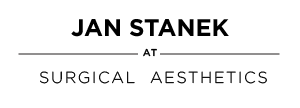Calf Implants by Jan Stanek at Surgical Aesthetics London
Calf size can vary from very large to “stick-like” legs. Body builders who have poor calf muscles, in spite of determined efforts to build them up, may not achieve a decent size and some women have very thin legs they may feel very conscious about. Some individuals with thin legs feel so self-conscious about them that they avoid exposing them by wearing trousers all the time. The operation aims to enhance the size of calf muscles by inserting implants between the sheath of the muscle and the muscle itself. By using an implant, or a pair of implants, this can produce an aesthetically pleasing effect.
The implants are made of solid silicone and are oval shaped available in different lengths and widths to suit the shape and size of each individual. It is not possible to make very major changes in calf size due to the limited space into which these implants are inserted. The change is ultimately governed by the surgeon’s aesthetic sense.
The operation is carried out through an incision in the skin crease behind the knee, approximately 1.5 inches in length. The sheath of the calf muscle is then incised, and a pocket fashioned, slightly larger than the implant, which is then inserted into it. The wound is closed and drains are left in place to drain any excess fluid and blood.
After the operation any attempt to walk is usually painful, especially when the heel touches the ground. This is due to the pressure and stretching of the muscle. This cramp-like pain subsides over a period of one week. Normal walking is usually possible within two weeks of the operation.
Calf Implants: The Risks and Possible Complications
All surgical procedures carry a risk of complications and your decision to go ahead with surgery should be based on balancing the risks and benefits. Although this operation is carried out with utmost care and skill it is possible to incur the following complications. They are all infrequent but may happen to you.
Infection: Should this occur the implant may temporarily be removed until the infection is cured.
Bleeding: This is very uncommon and may result in excessive accumulation of blood in the pocket in spite of having drains.The treatment is to drain the excess blood and stop the bleeding, if necessary.
Disturbance of sensation :During the fashioning of the pocket, nerves may be stretched or even damaged. This can result in temporary or permanent change of sensation on the back of the calf. In most cases this problem settles down over a period of time without intervention.
Deep vein thrombosis: Attempts to use overlarge implants or excessive collection of blood or fluid in the pocket can put pressure on the deep veins of the leg and cause thrombosis. It is preventable by using sensibly sized implants and draining any collection of fluid or blood, should this accumulate.
Hypertrophic or keloid scarring: Some individuals form scars which are raised, itchy and irritable. This condition becomes apparent several months after surgery and may require treatment.
Capsule contracture: The natural reaction of the body is to form a capsule around the implant. In some cases this capsule can constrict the implant to such an extent that the implant becomes buckled, or displaced. Should this occur it may be necessary to intervene surgically to enlarge the calf pocket, and remove the constriction.
Displacement of implants: This can occur after surgery since implants are not fixed in position and can move freely during the first few weeks. For that reason it is important to strictly adhere to postoperative instructions.
As with all cosmetic surgery it is essential to discuss your problem with the surgeon you feel you have a rapport with. He will tell you whether this particular operation is an appropriate remedy for your complaint and will answer any questions you may have.
Find out more
For more information about calf implants, or to book a consultation with Jan Stanek at Surgical Aesthetics in London, please enquire below.





